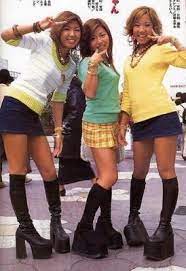
BEGINING
It could be said that Gyaru began in Japan in the 70s and 80s when several young girls began to disagree with the standards of what a Japanese woman should be at that time, not only in appearance but also in attitude and lifestyle, girls should be: submissive, dependent on men, dress modestly, take care of the home, have white skin, natural hair, among other things. The Gyarus sought to be the opposite of these beliefs, inspiring themselves in American girls since from their point of view they were the girls with the most free lifestyle.
Young Gyarus began to break the imposed standards, dyeing their hair light colors, going to tanning salons, and wearing more expressive and colorful clothing—the goal was to look more Western. They not only adopted their appearance but also their lifestyle, partying frequently. Gyarus began to be viewed negatively for this lifestyle, also because they spoke loudly and in an informal manner, but that didn't stop them; they were achieving their goal.
Shibuya established itself as a meeting point for gals, being one of the most representative places of the subculture.

1990s
During this time, gal began to gain popularity among girls still in school, who had to adapt their style to their school uniform. They were called "Kogyaru" or young gyaru. Although they tanned and dyed their hair, they had to maintain their style somewhat limited by the uniform. This allowed them to embrace it, because they uniform was stylish, they used it casually. Thus, the uniform became an essential part of their style of dress. The Kogal girls could be considered the true beginning of what is now known as gyaru.

2000s
By this time, gyaru was already a very popular and attainable style, anyone could be a gyaru. In March 2000, Egg magazine released a cover that changed gyaru forever. The cover of model Buriteri, with a prominent tan, white and extravagant eye makeup, was a revolution for what had been the style. At that time it was called Buriteri Style, however, it later changed to "Ganguro," which is how gyaru with very tanned skin are called. Those who did not tan were called "Ganjiro," or white-skinned gyaru

Ganguro evolved to unimaginable extremes, so much so that the term "Yamamba" emerged to refer to a Ganguro who took her style to the next level. In reality, this substyle stems from a very sad reality: many of these girls, either due to their revealing clothing or their lifestyle, began to be seen as easy girls. Gyarus, to avoid harassment, began using this "ugly" makeup to scare off this segment of society. However, it's worth clarifying that these days the intention is no longer to cause discomfort; it's simply another style.
Over time, in the mid-2000s, these styles began to become less popular, which led to the creation of many other styles. I'm not going to mention all of these styles because it would be too long, but let me know if you're interested in a blog about each style.
2010
By this time, gyaru had become international; it wasn't just Japanese women who used it. All women used it, specially Spanish women, who began translating the first magazines into Spanish.
More and more styles were created, some extravagant, some more subtle, but always following the basics of gyaru. Everything was going well for gyaru... until it didn't anymore.
Magazines lost popularity with the prominent arrival of digital technology; many important magazines folded, which greatly affected the subculture. It also caused many gyaru to move on to other, much simpler fashions of the time. Magazines that were still around and brands that were previously gyaru began to focus on other styles, seeing that gyaru's popularity had declined. At this point, many gyaru abandoned the subculture.
2020 - NOW
In 2020, the pandemic that forced us to stay home also led to widespread use of social media. Back then, there was a surge of nostalgia for the 2000s, which led to girls who were still doing gyaru becoming popular, those who were doing it becoming gyaru again, and those unfamiliar with the style discovering it and becoming interested in it. Overall, gyaru became well-known and popular again, sparking a gyaru renaissance, so to speak.
links:
The gyaru wiki
galture
Eiko_Gyaru











